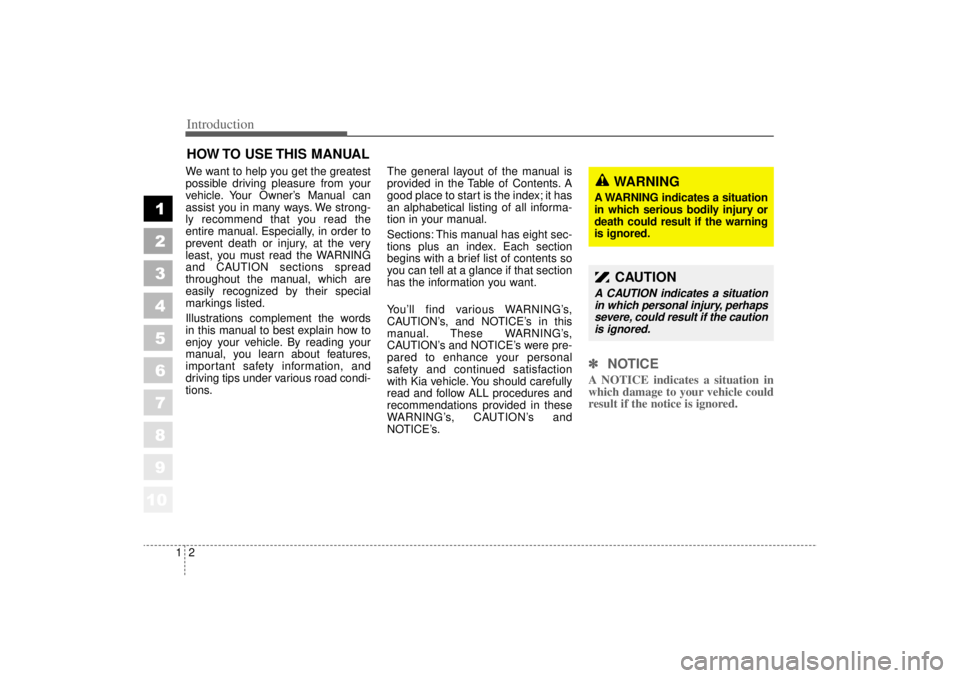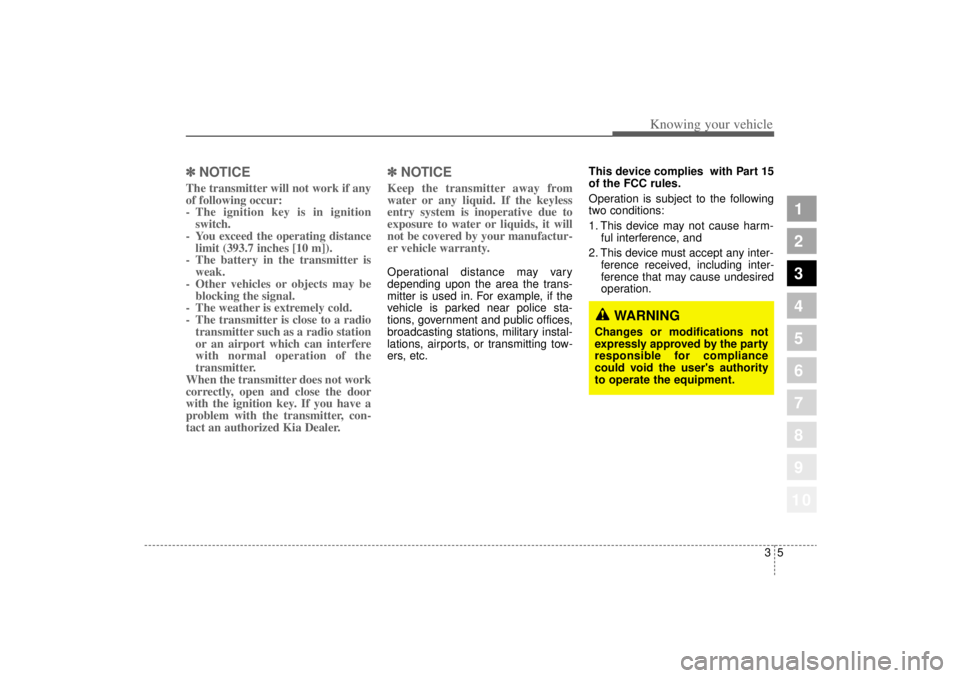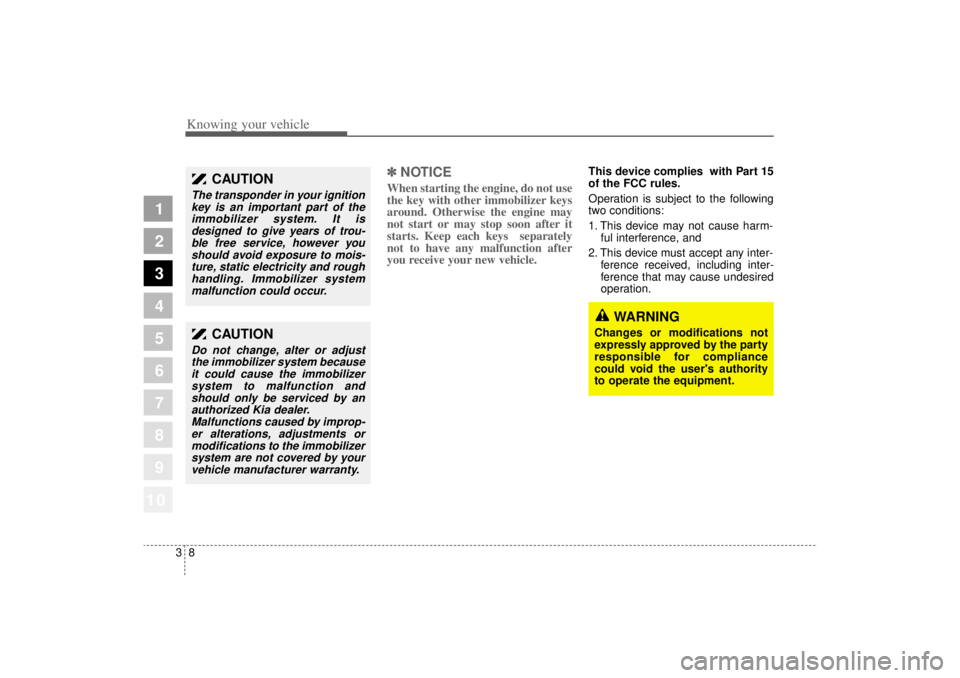Page 3 of 322
ii
1
2
3
4
5
6
7
8
9
IntroductionYour vehicle at a glanceKnowing your vehicleDriving your vehicleDriving tipsIn case of an emergencyMaintenanceSpecificationsConsumer assistance (U.S. only)
10
Index
table of contents
Page 5 of 322

1
2
3
4
5
6
7
8
910
Introduction21We want to help you get the greatest
possible driving pleasure from your
vehicle. Your Owner’s Manual can
assist you in many ways. We strong-
ly recommend that you read the
entire manual. Especially, in order to
prevent death or injury, at the very
least, you must read the WARNING
and CAUTION sections spread
throughout the manual, which are
easily recognized by their special
markings listed.
Illustrations complement the words
in this manual to best explain how to
enjoy your vehicle. By reading your
manual, you learn about features,
important safety information, and
driving tips under various road condi-
tions.The general layout of the manual is
provided in the Table of Contents. A
good place to start is the index; it has
an alphabetical listing of all informa-
tion in your manual.
Sections: This manual has eight sec-
tions plus an index. Each section
begins with a brief list of contents so
you can tell at a glance if that section
has the information you want.
You’ll find various WARNING’s,
CAUTION’s, and NOTICE’s in this
manual. These WARNING’s,
CAUTION’s and NOTICE’s were pre-
pared to enhance your personal
safety and continued satisfaction
with Kia vehicle. You should carefully
read and follow ALL procedures and
recommendations provided in these
WARNING’s, CAUTION’s and
NOTICE’s.
✽ ✽
NOTICEA NOTICE indicates a situation in
which damage to your vehicle could
result if the notice is ignored.
HOW TO USE THIS MANUAL
WARNING
A WARNING indicates a situation
in which serious bodily injury or
death could result if the warning
is ignored.
CAUTION
A CAUTION indicates a situation
in which personal injury, perhapssevere, could result if the cautionis ignored.
Page 16 of 322

35
1
2
3
4
5
6
7
8
910
Knowing your vehicle
✽ ✽NOTICEThe transmitter will not work if any
of following occur:
- The ignition key is in ignition
switch.
- You exceed the operating distance limit (393.7 inches [10 m]).
- The battery in the transmitter is weak.
- Other vehicles or objects may be blocking the signal.
- The weather is extremely cold.
- The transmitter is close to a radio transmitter such as a radio station
or an airport which can interfere
with normal operation of the
transmitter.
When the transmitter does not work
correctly, open and close the door
with the ignition key. If you have a
problem with the transmitter, con-
tact an authorized Kia Dealer.
✽ ✽ NOTICEKeep the transmitter away from
water or any liquid. If the keyless
entry system is inoperative due to
exposure to water or liquids, it will
not be covered by your manufactur-
er vehicle warranty. Operational distance may vary
depending upon the area the trans-
mitter is used in. For example, if the
vehicle is parked near police sta-
tions, government and public offices,
broadcasting stations, military instal-
lations, airports, or transmitting tow-
ers, etc. This device complies with Part 15
of the FCC rules.
Operation is subject to the following
two conditions:
1. This device may not cause harm-
ful interference, and
2. This device must accept any inter- ference received, including inter-
ference that may cause undesired
operation.
WARNING
Changes or modifications not
expressly approved by the party
responsible for compliance
could void the user's authority
to operate the equipment.
Page 19 of 322

Knowing your vehicle83
1
2
3
4
5
6
7
8
910
✽ ✽NOTICEWhen starting the engine, do not use
the key with other immobilizer keys
around. Otherwise the engine may
not start or may stop soon after it
starts. Keep each keys separately
not to have any malfunction after
you receive your new vehicle.
This device complies with Part 15
of the FCC rules.
Operation is subject to the following
two conditions:
1. This device may not cause harm-
ful interference, and
2. This device must accept any inter- ference received, including inter-
ference that may cause undesired
operation.
CAUTION
The transponder in your ignitionkey is an important part of theimmobilizer system. It isdesigned to give years of trou-ble free service, however youshould avoid exposure to mois-ture, static electricity and roughhandling. Immobilizer systemmalfunction could occur.
CAUTION
Do not change, alter or adjustthe immobilizer system becauseit could cause the immobilizersystem to malfunction andshould only be serviced by anauthorized Kia dealer.Malfunctions caused by improp-er alterations, adjustments ormodifications to the immobilizersystem are not covered by yourvehicle manufacturer warranty.
WARNING
Changes or modifications not
expressly approved by the party
responsible for compliance
could void the user's authority
to operate the equipment.
Page 27 of 322

Knowing your vehicle16
3
1
2
3
4
5
6
7
8
910
Window opening and closingThe driver’s door has a master power
window switch that controls all the
windows in the vehicle. To open or
close a window, press down or pull
up the front portion of the correspon-
ding switch.
Automatic power windowDepressing or pulling up the power
window switch momentarily to the
second detent position (
\b) com-
pletely lowers or lifts the window
even when the switch is released. To
stop the window at the desired posi-
tion while the window is in operation,
pull up or depress the switch
momentarily to the opposite direction
of the window movement.
If the battery has been discharged
or disconnected, the automatic
power window system must be reset
as follows:
1. Turn the ignition key to ON posi- tion.
2. Close each window and continue pulling up on each power window
switch for at least 0.5 second after
the window is completely closed. Automatic window reversal (When
window is closed by the automatic
power window)
If the upward movement of the win-
dow is blocked by an object or part of
the body, the window will detect the
resistance and will stop upward
movement. The window will then
lower approximately 5.9 inches (150
mm) to allow the object to be
cleared.
1GHA2301A
1GHA2300C1GHA2300A
Page 29 of 322
Knowing your vehicle18
3
1
2
3
4
5
6
7
8
910
Driver’s seat
➀
Seat adjustment, forward / back-
ward/height (see page 3- 20)
➁
Seatback recliner (see page 3- 22)
➂
Seat heater switch (see page 3- 22)
➃
Lumbar support (see page 3- 23)
➄
Driver position memory system
(see page 3- 24)
Headrest adjustment (headrest
can not be adjusted by a switch)(see page 3- 24)
Front passenger seat
\b
Seat adjustment, forward / back-
ward (see page 3- 25)
➆
Seatback recliner (see page 3- 26)
➇
Seat heater switch (see page 3- 27)
Headrest adjustment (headrest
can not be adjusted by a switch)(see page 3- 28)
Rear seat
\f
Seat heater switch (left) (see page 3- 31)
➉
Seat heater switch (right)(see page 3- 31)
Headrest adjustment (see page 3- 32)
SEAT
ESP
5GHN2025
Page 32 of 322
321
1
2
3
4
5
6
7
8
910
Knowing your vehicle
Adjusting front height of seat cushion
Move the front portion of the control
knob up to raise or down to lower the
front part of the seat cushion.Adjusting rear height of seat cushion
Move the rear portion of the control
knob up to raise or down to lower the
rear part of the seat cushion.Adjusting the height of seat cushion
To raise or lower the seat cushion,
pull up or push down on the center of
the corresponding switch. Release
the knob once the seat reaches to
the desired position.
5GHA2239
5GHA2240
5GHA2241
Page 90 of 322

379
1
2
3
4
5
6
7
8
910
Knowing your vehicle
How does the air bag system
operate Air bag only operates when the
ignition switch is turned to the ON
or START positions.
Air bags inflate instantly in the
event of serious frontal or side col-
lision (if equipped with side air bag
or curtain air bag) in order to help
protect the occupants from serious
physical injury.
There is no single speed at which
the air bags will inflate.
Generally, air bags are designed to
inflate by the severity of a collision
and its direction. These two factors
determine whether the sensors
send out an electronic deploy-
ment/inflation signal.
Air bag deployment depends on a
number of factors including vehicle
speed, angles of impact and the
density and stiffness of the vehi-
cles or objects which your vehicle
hits in the collision. However, fac-
tors are not limited to those men-
tioned above.
The front air bags will completely
inflate and deflate in an instant.
It is virtually impossible for you to
see the air bags inflate during an
accident. It is much more likely that
you will simply see the deflated air
bags hanging out of their storage
compartments after the collision.
In order to help provide protection
in a severe collision, the air bags
must inflate rapidly. The speed of
air bag inflation is a consequence
of the extremely short time in which
a collision occurs and the need to
get the air bag between the occu-
pant and the vehicle structures
before the occupant impacts those
structures. This speed of inflation
reduces the risk of serious or life-
threatening injuries in a severe col-
lision and is thus a necessary part
of air bag design.
However, air bag inflation can also
cause injuries which normally can
include facial abrasions, bruises
and broken bones, and sometimes
more serious injuries because that
inflation speed also causes the air
bags to expand with a great deal
force.
There are even circumstances
under which contact with the
steering wheel air bag can cause
fatal injuries, especially if the
occupant is positioned exces-
sively close to the steering
wheel.